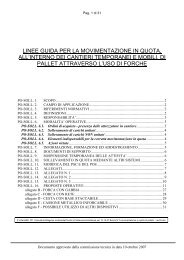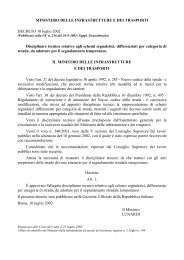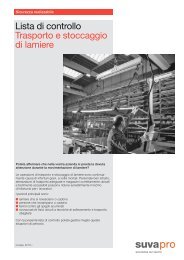Riconquistiamo il paesaggio - ACCA software SpA
Riconquistiamo il paesaggio - ACCA software SpA
Riconquistiamo il paesaggio - ACCA software SpA
Create successful ePaper yourself
Turn your PDF publications into a flip-book with our unique Google optimized e-Paper software.
182<br />
CAPITOLO III - Paesaggi d’Italia<br />
with changes to FOREST), to HETEROGENEOUS (mainly towards other agricultural land classes<br />
and towards FOREST), and to WOODED (mainly to HETEROGENEOUS and to FOREST).<br />
We found also that land-use/land-cover change occurred with different intensities in the various<br />
parts of the peninsula (Fig. 4). In particular, we considered (Fig. 2): the Alps, the Apennines, the<br />
Po river plain, the coastal areas, the island of Sardinia and the island of Sic<strong>il</strong>y. These macro-regions<br />
were identified using geographic, geomorphologic and bioclimatic factors (Tomaselli et al.<br />
1973) together with national and international agreements(Alpine Convention 96/191/CE;<br />
http://www.convenzionedellealpi.org/index; APE – Apennines Park of Europe G.U. 29/03/2001).<br />
PASTURE decreased markedly in all Italy, but particularly in the Apennines, in the coastal areas<br />
and in Sardinia. On the contrary, FOREST increased in all Italy, almost doubling its extension in<br />
the Alps and the Apennines and increasing even more in Sardinia. AGRICULTURE decreased in<br />
the Alps, in the Apennines, in the coastal areas and in Sic<strong>il</strong>y, but it increased in the rest of Italy.<br />
HETEROGENEOUS and WOODED followed a more complex trend, with important changes<br />
especially in Sardinia, where we measured a marked increase in HETEROGENEOUS. ARTIFI-<br />
CIAL increased throughout the peninsula: coastal areas, Sardinia, Sic<strong>il</strong>y and the Po river plain showed<br />
a marked increase, wh<strong>il</strong>e only a limited increase was measured in the Apennines and,<br />
especially, in the Alps.<br />
2. Land uses and misuses and their implications for biodiversity conservation<br />
Our analysis is supported in its results by other studies that have indirectly considered the Italian<br />
peninsula. FAO (2005), using completely different datasets and techniques (and with no spatial<br />
deta<strong>il</strong> inside the country level), reports that in 2005 34% of the Italian territory was covered<br />
by forests (compared to the 32.54% that we measured for 2000) and that the annual rate of<br />
change in forest cover for the time period 1990-2000 was 0.3% (compared to the 0.2% that<br />
we measured for the same time frame). Comparable results have been obtained from EEA<br />
(2005) that measured the same trends that we described for pastures and forests using the same<br />
datasets but different techniques. These studies give a further confirmation of the reliab<strong>il</strong>ity<br />
of the change rates that we obtained.<br />
Our results demonstrate that from the 1960s, Italy’s mountainous and h<strong>il</strong>ly areas (particularly<br />
the Alps and the Apennines) have changed towards more “pristine” conditions and the coastal<br />
areas towards a more human dominated landscape. The land-use/land-cover changes seem to<br />
be associated to changes in human population density, which appear to be inversely related to<br />
the increase in forest cover (Alps and Apennines) and decrease in pastures and other traditional<br />
agricultural uses (as is the case in Sardinia; Fig. 5).<br />
FOREST increased from the 1960s to 2000, replacing mainly agricultural areas and PASTURE<br />
(refers to Tab. 1-2). During the same period, PASTURE drastically decreased and agriculture (including<br />
AGRICULTURE, HETEROGENEOUS and WOODED) remained mostly unchanged. However,<br />
the land-use classes representing more traditional and less intensive cultivations decreased<br />
(WOODED and, in the Alps, HETEROGENEOUS) or remained stable (HETEROGENEOUS),<br />
wh<strong>il</strong>e AGRICULTURE, the land use type that includes the more intensive cultivation types, increased<br />
in plain areas (despite an overall decrease), indicating an increase in modern-industrybased<br />
agriculture and a decrease in traditional types of agriculture.<br />
A major caveat on these results is given by their purely quantitative aspects. The type of data<br />
used does not permit any insight into the “quality” of the land-use/land-cover classes and we<br />
could not obtain any indication regarding the ecological functionality of what we found. However,<br />
Tellini-Florenzano (2004) measured, for the Apennines, a significant aging for different types





